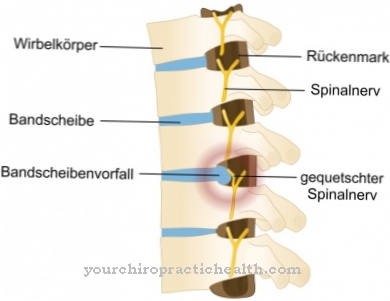As First pass effect the doctor describes a biochemical metabolism process in the first passage through the liver, which transforms drugs taken orally into so-called metabolites and thus either weakens or activates their effectiveness.
The intensity of the metabolism in the liver is directly related to the individual liver functions and can therefore differ from patient to patient. The first-pass effect is particularly important in drug development, as it is inextricably linked to the bioavailability of drugs.
What is the first pass effect?

During the first passage through the liver, a drug is biochemically converted. The extent to which this conversion is carried out depends on the patient's own liver function. The doctor also describes the biochemical conversion process itself as metabolism.
The metabolism in the first passage through the liver is again referred to medically as the first-pass effect and results in an intermediate product that has little to do with the actual medicinal substance. Either the metabolism switches off the effectiveness of a drug, or it results in an effective product, for example in the case of oral drugs that were developed with the first-pass effect in mind.
While some drugs lose their effectiveness as a result of the first-pass effect, others are only activated when they are metabolized. In direct connection with this, pharmacokinetics understands the concept of the first pass effect as the amount of extract of a drug after the first passage through the liver.
Function, effect & goals
The first pass effect primarily plays a role for peroral drugs, i.e. for all drugs that can be swallowed. This includes tablets, coated tablets and capsules as well as medicinal solutions for drinking.
After oral ingestion, the drug enters the stomach, from where it moves on to the small intestine. The agent begins to be absorbed in the stomach as well as in the small intestine, so that it can enter the bloodstream and develop its effect. However, the stomach and small intestine are both connected to what is known as the portal vein system, which means that medicinal substances first reach the liver during this process. Only after they have passed through the liver passage do they get into the rest of the body with the blood and are distributed there in order to reach their intended location.
Biochemical reactions, such as the first-pass effect, occur both when crossing the intestine and when crossing the liver passages. The enzymes of the orally taken drugs are split and assigned to chemical groups. During these metabolizations, metabolites arise as reaction products, with the body generally trying to deactivate the exogenous drugs. As a rule, the water solubility of exogenous substances increases in the course of the metabolism, since the organism wants to excrete the foreign substances as quickly as possible.
So if there is an extreme first-pass effect, then the respective drug never reaches its target because it is excreted long beforehand. This reduces the bioavailability and general effectiveness of the drug. On the other hand, the so-called prodrugs make use of the first-pass effect, because they are drugs that correspond to the precursors of an effective metabolite. This means that only when they are metabolized in the liver do they become effective substances against a specific complaint.
The inclusion of the first pass effect generally plays a special role in patients with liver disease. The desired form of metabolism is particularly relevant for the topical application of drugs, in which, after absorption, the side effects on the entire organism can also be significantly reduced.
Risks, side effects & dangers
Except in the case of prodrugs, the first-pass effect with peroral drugs is usually an undesirable side effect. There are several ways to avoid this side effect. For example, the rectum is not connected to the portal vein system. For this reason, suppositories can be used to circumvent the first-pass effect, for example.
Other ways of administering drugs independently of the gastrointestinal passage are transdermal patches or intravenous and intramuscular injections. Ultimately, all parenteral, sublingual and buccal drug administration are basically suitable for bypassing the liver passage. As long as this is possible without increased risks, an increase in the dosage can also restore the effectiveness of the oral drug. In this way, enzymatic processes and protein-mediated transport processes can be saturated so that the first-pass effect is almost always linked to a specific dose of the respective agent.
Above a certain dosage, all processes that weaken the active ingredient are saturated and the respective system automatically has higher amounts of the active ingredient available. The saturating concentration of the respective drug is also known as the breakthrough dose. However, the dosage cannot be increased at will, since every increase in the liver's internal metabolic capacity has negative consequences. A special feature of the metabolism process in the liver is its individuality. The first pass effect thus varies from one person to another and is directly related to their liver functions.
Correspondingly, the breakthrough dose for a particular drug also varies with the patient and his liver qualities.In patients who do not initially show a noteworthy first-pass effect for a certain drug in a certain dosage, however, metabolism can still occur after some time. If, for example, certain enzymes are increasingly formed in the liver as a result of taking the medication, this enzyme induction may also reduce the effectiveness of the medication with long-term use.













.jpg)

.jpg)
.jpg)











.jpg)